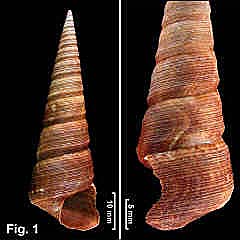|
|
|
|
Maoricolpus roseus (Quoy & Gaimard, 1834) Description: Protoconch of 2½ whorls, teleoconch up to 18 whorls in adult shells. Whorls slightly concave to slightly convex, suture impressed. Whorls spirally sculptured; latter whorls with 20-30 threads varying in size, usually with one stronger near bottom of whorls. Axial sculpture of sparse growth lines conforming to shape of outer lip sinus. Inner lip of aperture only weakly reflected outwards at base; outer lip thin, with a moderate sinus, lip often broken. Base sculptured similarly to whorls. Colour fawn to reddish or purplish brown, marbled or streaked in darker brown. Operculum circular, corneous. Size: Up to 90.8 mm in length, commonly 60-70 mm. Distribution: New Zealand and Australia; in Australia, from Sydney, NSW, southwards to the east and north coasts of Tasmania; presently spreading westwards and northwards. Habitat: Lives on fine silts, muds, and sandy, gravelly or shelly substrates from the low intertidal down to about 200 m. Abundant in New Zealand and Tasmania, common in southern NSW, rare around Sydney. Comparison: The characters that distinguish this species in the NSW fauna are its large size, brown colouration, multi-whorled protoconch, and sculpture of many fine threads. Remarks: This species was probably introduced into Tasmania in the 1930s with oysters for farming from New Zealand. By 1964 it was common in D'Entrecasteaux Channel south of Hobart (Greenhill, 1965) and has since been recorded throughout eastern Tasmania, Bass Strait, and northwards to Sydney, NSW. It was common at Twofold Bay in southern NSW in 1993-1996 (Bax et al. 2003). Three dead shells were collected at Bottle and Glass Rocks in Sydney Harbour by Ashley Miskelly in 2000 (A. Miskelly, pers. comm.) The habitat in New Zealand is from the low intertidal to about 200 m, on fine silts, muds, and sandy, gravelly or shelly substrates. In Australia it lives on similar substrates, and can reach densities of up to 600 individuals per square metre. It is a suspension feeder, laying in a stationary position on, or partly buried in, the substrate, filtering suspended organic material from the water drawn across its gills. The maximum shell size recorded is 90.8 mm, but growth rate and maximum size vary between locations. One study found that a shell from Tinderbox, Tasmania, of 64 mm in length and of 14 whorls was three years old (Allmon et al, 1994). Another study of shells from Pirates Bay in Tasmania found that specimens 57 and 75 mm in length were 5 and 6 years old (Scott, 1997). The species has separate sexes, in contrast to some turritellids which are protandrous hermaphrodites. Sperm released by the male is taken up by females in the inhalant water flow. Fertilised eggs are deposited into egg capsules held as a conspicuous yellow mass in the female mantle cavity. Eggs develop within the egg capsules to trochophore larvae and then veligers while still held in the female. Development after this stage is uncertain, but it appears that the veligers are released for a short planktonic period before settling on the substrate (Bax et al., 2003). This screw shell is so abundant in some areas that the benthic habitat has been altered from fine sand or mud to one with a dense cover of live and dead shells and faecal pellets (Bax et al, 2003). It is suspected that this has contributed to a severe decline in numbers of other mollusc species in the area, including Gazameda gunnii. Fig. 1: Dover, Tasmania (DLB4083). |
